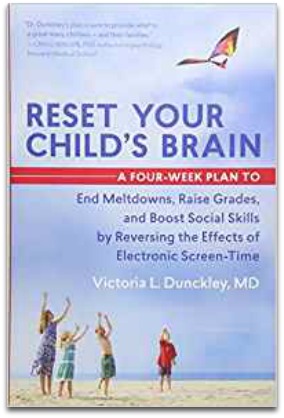 A few months ago, my phone required a reset in hopes it would respond better to its master. Afterward, I realized that all my notifications had been turned off.
A few months ago, my phone required a reset in hopes it would respond better to its master. Afterward, I realized that all my notifications had been turned off.
No little red bubbles reminded me that someone had liked my Facebook post or retweeted my genius. I started to turn them on again, but then . . . I didn’t.
And I haven’t since.
I realized I was tired of 24/7 availability.
While we wring our hands trying to figure out how to help our children avoid electronic screen addiction, most of us have to admit it’s not only a problem for young people. Our buzzing, chirping, dinging world affects everyone—and families can work together to make themselves less slavish to its electronic siren songs.
Research would suggest that we start.
Researchers conducted a series of experiments with volunteers aged 18 to 77, requiring them to sit alone for fifteen minutes with no outside stimulation. Over half of the participants disliked being alone with their thoughts so much that they gave themselves mild electric shocks as a distraction during the 15-minute session of quiet thinking.
The average American spends a little over ten hours a day looking at screens—leaving precious little time for human interaction and play, two of the healthiest things we can do. That’s more than equivalent to a full time job.
Of course, some of that time is our jobs—I feel attached to this MacBook more hours than I like to admit, because screens are my job, but they’re also my addiction, if I’m totally honest. I should put them down after five—but I don’t always.
On a test of electronic addiction, I scored “moderately addicted.” Seeing that kind of statistic for myself isn’t OK, and it’s worse for our kids.
Expert psychiatrist Victoria Dunckley has created a test to see if we can spot the signs of screen addiction, with questions like:
Does your child become irritable when told it’s time to stop playing video games or to get off the computer?
Do you ever feel your child is not as happy as he or she should be, or is not enjoying activities as much as he or she used to?
Does your child prefer socializing online over face-to-face interactions?
Your child is not alone.
The Archives of Pediatrics and Adolescent Medicine reports that the more hours teens spend in front of a TV or computer, the weaker their bonds with parents, and the opposite happens when they spend time reading or doing homework.
Other studies have found correlations between screen time and child obesity, high risk behaviors, and lack of sleep.
And did you know that grades drop with every hour of screen time?
The news is not all dire, though. Teens who spend time interacting (as opposed to lurking) on social-networking sites display more “virtual empathy” toward others. They are able to understand and sympathize with more people.
There are multiple opportunities for friendships and cultural discovery online. We found an exchange student that way. Many others who communicate with people from other countries, ethnicities, and religions have found that these conversations make them more open to human differences.
The electronic world also opens doors for kids with disabilities they never would have found otherwise.
We don’t want to eliminate devices from our kids’ lives and have them crawl into a cave somewhere. We do want to learn wise use, allowing us the freedom to use devices but not allowing them to use us. This iPhone is not the boss of me.
When I ponder this puzzle of electronic overload, I have to include me in the solutions. There are many suggested solutions, or at least mitigators, for our pervasive electronic screen addictions. Here are a few.
It’s Okay Not to be Available
 I remember discussions with my youngest on why she had to bring her phone to the table.
I remember discussions with my youngest on why she had to bring her phone to the table.
“Because someone might text me.”
“But do you have to answer?” I asked her.
She looked at me like I was Wilma Flintstone. How could I not understand she needed to be 24/7 available?
If I’m honest, I have the same problem. Don’t I jump to answer texts and view my instagram hearts? I see the dangers, however, in making myself available to everyone at a all times, and I see what it does to my relationships when people feel I’m at their command.
So my daughter and I started talking about that need to respond to all the whistles and beeps. I asked some questions to help her learn to assess on her own.
Do you want some downtime in your life?
What would that look like?
How can you make sure your friends know they’re loved but you’re not always available?
What kinds of limits do you want to set?
Kids don’t know they have a choice not to heed the call of their phones. They have to see adults practice it and hear us talk about it. They need to see us ignore a call or a text because we’re talking to them. If my kids see me opting out of the noise, they know they can, too.
So I’ve changed a few things in my life. I left those notifications off. There is no immediate anxiety about not answering. I turn off the sound when I’m working on the computer. I close email programs and facebook so I don’t see their insistent call for my time and attention.
I won’t apologize for not answering texts and emails if I’m doing something sacred. (Something sacred includes talking to my kids, taking a nap, going on vacation, or anything else I say it is.) That tells my kids that being unavailable is a guilt free choice.
Create Quiet Zones
Use positive phrasing rather than the negative “no tech zone” or “no phones time.” That makes what should feel like freedom into a punishment.
Decide for yourself specific times or places when tech is put away and people are priority. For younger kids, time limits work well. (You can use the iPad from 11-12 and 3-4, and the rest of the time is Creative Time!)
For older ones and parents, an emphasis on “zones” works better. That means you decide what places and times are off limits for screens.
Many parents collect devices an hour before bedtime and then take that time for stories of the day, reading, talking, planning, and dreaming. Some refuse to allow devices in the car, while others use them only in the car. (I’m assuming that if you’re driving, you never use them.)
In our family we do not allow them to be used in the car. The car, in our experience, is the best place for talking. Something about side-by-side rather than face-to -face opens kids up to talk less guardedly.
Some parents choose to allow devices only on weekends or for an hour after dinner. Mealtimes are everyone’s favorite tech-free time for real face-to-face connection. And bedrooms, according to virtually all pediatricians, are the worst possible place for any technology.
Doctors unanimously agree that the dangers are too great and parents should fight to keep bedrooms places of refuge from devices. Find a cute basket to designate as your screen drop spot.
Decide together what works for your family and choose your tech free zones. Having these zones tells our kids that “we” is an important thing. Attention is something we do, and together is more than side-by-side.
Plan Alternatives
You know that glazed-eye feeling when you’ve sat looking at Facebook for just too long? It’s so easy. Another click is a lot less work than thinking of something else to do.
I’m a creature of inertia, so thinking of another activity and having quick access to it takes far more fuel than sitting and scrolling.
The key is to have plans for something else. If we have a list of non-electronic defaults at hand and the materials needed for them, we’re a lot more likely to get our kids, and ourselves, away from the screen.
Things on our list include: Volunteer somewhere. Get outside and take a hike, learn to geocache, or clean up a playground. Take an art class or do an art project. Have a snowball fight or a library trip. Bake cookies. Have a real discussion (we had boxes like these of topics to begin with). I created scavenger hunt lists that could be at the ready for bored times that could otherwise lead toward screens.
Keep books right where you normally sit so they are easy to grab instead. Set up board games, puzzles, or art supplies in a central location for easy access. Alternatives need to be as easy as devices.
Change the Default
When we moved into our house, my husband and I chose to put our television to the side of the room rather than the obvious space the previous owners had used up front. We didn’t want to make it central to our family room life.
We can subtly make technology the centerpiece in our home, and that makes it harder to establish other options. More than planning alternatives, when we take intentional steps to dethrone tech, we’re sending the message to our family that our lives do not revolve around media.
We parents need to look at the culture we’re creating in our home and bravely choose another default. We can centralize an art table instead of a TV or a computer. We can create an outdoor toy space that’s easier to access than a tablet. We’re creatures who pick what’s first seen and easiest to get to. So why not make that something that isn’t a screen?
Take a Break
 If you think there’s a problem for someone in the house, or if you want to prevent one, challenge the family to occasional media fasts. Get each person to fast from one or more forms of media—facebook, music, texting, snapchat, TV, etc. for a week.
If you think there’s a problem for someone in the house, or if you want to prevent one, challenge the family to occasional media fasts. Get each person to fast from one or more forms of media—facebook, music, texting, snapchat, TV, etc. for a week.
Make it competitive! Every time they cave, they have to put a dollar in a jar. Whoever wins by fasting from the most media and putting in the fewest dollars chooses the charity they go to, your next vacation spot, or a fun activity.
Families can do this for a day, a week, or a month, as often as they want. Parents must also participate! (And have good grace when they lose!)
We chose to fast with a plan from Jen Hatmaker’s book, 7: An Experimental Mutiny Against Excess. We selected seven electronic forms we would fast from for a month. We’ve never felt freer from demands, and we kind of hated going back. This strategy teaches self-control and also offers a tangible reward for what was already an intangible one—peace.
 Our family has taken a Sabbath from electronics on Sundays. For one day a week, we are not in demand and can truly rest mentally, the most needed rest in our world.
Our family has taken a Sabbath from electronics on Sundays. For one day a week, we are not in demand and can truly rest mentally, the most needed rest in our world.
Dr. Victoria L Dunckley wrote the book Reset Your Child’s Brain. In it, she outlines her four-week program to shift a child’s brain function from screen addiction, an actual condition she calls Electronic Screen Syndrome (ESS), to healthier patterns.
She cites an improvement in outbursts, depression, and anger in children with ESS, as well as an improvement for kids diagnosed with ADD and Tourette’s, two conditions that tend to cause more dependence on electronics for kids. If a child is truly addicted, like anything else, an intensive removal of the trigger might be necessary.
Talk About It
Parents talk to their kids a lot about screen time rules, but what if we emphasized talking about exactly what we’re doing on the screen and how to make it healthy?
Try small conversations like:
“I think we need some exercise now. It’s not that healthy to sit too long. What should we do together?”
“I don’t think that game is good for learning to be kind. What else could we try?”
“You’ve really learned to move fast with that game. How about we go outside and you show me the same thing with a soccer ball?”
“I don’t want you to be stressed about homework not being done later, and we both want you to do well in school. So let’s get that done and then come back to this.”
“Some things on the computer are fun, but some might make you uncomfortable. Always come to me or dad and show us what you’re worried about. We won’t get mad. We want to help you be safe.”
Make Wise Choices Between What We Can Do and What We Should Do
 So, your child insists that “everyone” has a smart phone. If he’s between 14-17, this is true. 89% of teens have phones. However, only 31% of children 8-10 do. Of that 31%, virtually none actually needs a phone.
So, your child insists that “everyone” has a smart phone. If he’s between 14-17, this is true. 89% of teens have phones. However, only 31% of children 8-10 do. Of that 31%, virtually none actually needs a phone.
Even Bill Gates himself only allowed cell phones once his kids reached high school age. Steve Jobs also had very strict tech rules in his home. I feel affirmed now—that’s the same age we used for smart phone acquisition.
We tend to confuse what we can afford, have, or do with what we should do. Just because there’s an app out there to teach our kids how to brush their teeth, do we need it? What message will it send to our kids if we use it? Marketers have a big stake in convincing us we need all those apps and gadgets so our kids can keep up.
We are not required to listen and believe. Will my kid’s teeth fall out if I teach her to brush them with no help from a monitor? Will she really fall behind in school if she doesn’t have a tablet? We can say “no” to the push to make everything electronic.
It looks fun and effective to use the flashing, colorful apps and such, but really, our kids will enjoy us teaching them brushing, reading, counting, etc more than an electronic stranger. Remember—they make those things attractive for a reason. It’s our job as parents to resist and ask ourselves what we really should have rather than what looks good.
But let’s say your kid insists that he is ready for a cellphone. Well, how can we figure out if he really is ready?
Various experts recommend some tests to determine cell phone readiness:
- Do they show responsibility with their things, especially things they’re told are important?
- Do they act on impulse often, a sign that they might spend money or send inappropriate pictures or texts that they (and you) later regret.
- Do they accept change readily or fight it? If the latter, the possibilities of becoming addicted are greater, as devices are geared to make people stay as long as possible.
- Do they pick up on social cues well? If not, the potential for cyber bullying is very real and very dangerous.
- Do they participate in activities in which they need to be able to contact you readily?
- Do they show emotional maturity so that they can handle the envy social media often causes?
- Do they understand, really understand, that future colleges and employers will have access to anything they post?
- Do they communicate with you easily, so that you know they will come to you with a cyber situation they can’t handle?
- Do they have a healthy social life that will continue face to face or are they more likely to use a device to escape difficult real life conversations and relationships?
Accept a Compromise
There are days we won’t feel well, or our kids won’t. Days we’re super busy, or days we simply can’t play Legos one more minute. We’ll park our kids with the iPad or TV and let inertia win.
It’s OK. It’s one day. You’ll both be fine. We’re after healthy patterns, not perfection.
Electronics are here to stay, and they can be a great blessing to family life. If it weren’t for Snapchat, I wouldn’t see what my daughter is doing every day in a different city. Electronic screen addictions, though, are a choice—for me, and for my kids.
Connectivity is great, but connection makes us human. So now, I think I’ll go outside.
2-Minute Action Plan for Fine Parents
For today’s quick contemplation let’s think about screens.
- How many screens do you and your family have access to?
- How often do your children see you on your phone or tablet or computer?
- How often do you see your children with their noses in their own screens?
- Using Dr. Dunckley’s full list of signs of a possible screen addiction, assess your child and yourself on that scale.
- Decide what you want your central home focus to be other than screens. Sports, art, dramatic play, etc. Make plans to create that spot.
Long Term Action Plan for Fine Parents
In the longer term think about what you need to do to help get your children to stop using screens as their default activity.
Make your list of alternative activities, with your kids’ input. Post it in the places you’re most likely to sit with a screen.
Check with the local park district for classes or activities to take together. Sign up for one!
Set up your own art table, nature center, or sports equipment area with easy access.
Make a plan for a media fast. Determine what you will fast from, how long, and what the reward will be.

Fantastic read! These tips are exactly what my family needed. It’s a constant challenge to strike the right balance between screen time and quality family moments. Your insights provide a clear roadmap for creating a healthier digital environment. Excited to implement these strategies and foster stronger connections!
Just curious, do you know if the side effects of prolonged screen time apply to other activities? Can other childhood passions have bad effects when done too long? For example, my son of age 6 loves to read. He makes a weekly trip to the library and comes home with a shopping bag full of books. If left to his own devices, he would easily spend 3-4 hours a day reading. He shows similar signs of irritability when we ask him to put the books down and go do something else. I don’t know if we are dealing with “book time” addiction or if his hobby is fundamentally different because it’s reading, not watching TV/playing video games.
Hi Brent (Hey, that’s my husband’s name!),
Excellent question. I think, from the research I’ve read, that screen addiction is quite different for a few reasons. The screens themselves operate on the brain differently, causing inability to fall asleep and other effects that books don’t cause. The effects mentioned here appear to be related to screens by their nature of being created to be addictive, geared toward instant gratification, and more isolating, among other things.
So it doesn’t appear that reading, even excessively, would have the same negative effects, although it could have other ones. (For instance, there are negative effects of sitting inside and not getting out in nature that would cause irritability. Another example–being with other people teaches us to deal with irritating issues, and if we don’t practice, we don’t learn that.)
Having said that, it’s not uncommon for children (and adults) who gravitate toward activities that are more quiet and less social, like reading, to have a hard time with changing activities. (My sister would argue that I was much like your son as a child.) So probably some of the options people suggest for helping a child move from playing on a device to something else would be applicable in both instances. (Give a ten minute warning, etc.) Love the question, and it sounds like you have a great kid!